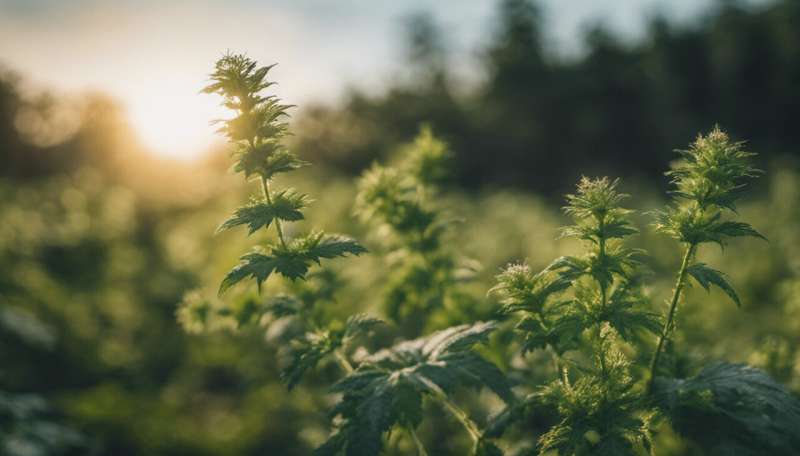This article has been reviewed according to Science X's editorial process and policies. Editors have highlighted the following attributes while ensuring the content's credibility:
fact-checked
trusted source
written by researcher(s)
proofread
Why we should all learn to love stinging nettles

Thinking of stinging nettles (Urtica dioica) may bring to mind childhood memories of legs burning as you whizzed down country lanes on your bike. Or itchy white bumps blooming on your hands and even face as you foraged blackberries from the hedgerow.
As an adult, you may have fresher memories of the pain from trying to weed persistent nettles from your garden. As soon as you think you've got them all, they spring up again like difficult relatives at Christmas.
Stinging nettles are not high on many people's lists of favorite plants. But there's so much more to this nettlesome species than people realize.
Let's start with the basics. Nettles are amazing colonizers of bare and disturbed ground. Their long-lived seeds can lay dormant in the soil for five years or possibly more. And those rhizomatous (interconnected) roots that make them so hard to cull from your flowerbeds are something of a plant superpower that helps them quickly establish new populations.
Charles Darwin's theory that nettle seeds could survive a long soak in salty water while using the sea to disperse them turned out to be right. A study in 2018 found their toughness enabled them to colonize overseas.
This may not sound like good news but intensive farming, urban sprawl and pollution is destroying nature. The wildlife in our gardens and countryside depends on plants, but climate change is making it harder for them to grow. Nettles' resilience makes them a vital tool in the fight to halt this nature crisis.
Wildlife friendly
Stinging nettles help wildlife survive, especially in urban and agricultural areas. In the UK, they are the caterpillar food plant for comma, painted lady, peacock, red admiral and small tortoiseshell butterflies. The spread of these nettles into our gardens and wasteland (from their natural woodland habitat) has allowed these butterflies to expand their range into our gardens and towns.
And it's not just butterflies that rely on nettles. Ladybirds often lay eggs on their leaves. This "gardener's friend" has a voracious appetite for aphids, those annoying little green and black flies that suck the sap from our delicate plants and ravage our veggies. Having nettles in our gardens and near our agricultural fields give ladybirds and other insects somewhere to shelter, ready to feast when the aphid population rises.

Stinging sensation
It is thought that nettles with more stinging hairs are eaten less by animals like rabbits, sheep and deer. So the reason that nettles sting is simple self-defense.
They have small hairs across their leaves and stems that, when brushed against an object, employ a mechanical defense (the silica hairs break off in the skin) and then a chemical one (release of irritants such as histamine into the skin). Considering the havoc humans wreak on nature, it seems a reasonable protective measure.
The broad-leaved dock plant (Rumex obtusifloius) likes similar growing conditions to stinging nettles so they are often found together. In fact, there is no evidence to suggest dock leaves treat nettle stings, but I still always use them—it can't hurt and makes me feel better.
Healing powers
If you're still not sold on nettles, let's talk about what they can do for our health. There is a long history of stinging nettles in folk medicine across Europe and further afield. And there is scientific evidence that nettles (or the extracts from their leaves, roots and stems) can treat hypertension (high blood pressure) and diabetes. They can even keep farmed fish and chickens in good health too.
Stinging nettles can be brewed into tea and beer, make delicious soup, and are used to wrap cheese. They are highly nutritious, full of vitamin A and C along with calcium and iron.
Nettles can also be used to make cloth. There is evidence that people in cool climates have used nettles since the Bronze Age to create textile fibers. These were popular until widespread sheep breeding increased the use of wool. Nettle fibers were also used in Europe during shortages caused by the world wars. Traditional fiber plants like cotton won't grow in cool, temperate climates, but nettles do fine.
Scientists are now investigating whether nettle fibers can help meet modern demands for clothing and car fabrics. Unlike cotton, they do not need fertilizer or herbicides, and can be grown on poor or even contaminated land. So they can be made into a plant-based fiber that doesn't compete with food production.
Hopefully you're convinced that stinging nettles are our friend and deserve a place in our countryside, even if they are annoying sometimes. You could even save yourself some weeding by leaving a small patch in your garden to tempt in some butterflies.
Provided by The Conversation
This article is republished from The Conversation under a Creative Commons license. Read the original article.![]()




















